Abstract
A quantitative model has been developed for the cooperative oxygenation of human hemoglobin. The model correlates the structural and energetic features of ligand-linked subunit interactions within the tetrameric molecule and the coupling of these interactions to the binding of oxygen and Bohr protons. Recent findings are incorporated regarding (i) the sites of regulatory energy change within the tetrameric molecule, (ii) the nature of the Bohr effect for tetramers and dimers, (iii) the fractional Bohr proton release at each stage of oxygenation, (iv) relative probabilities of binding to the alpha and beta chains within the tetramer, and (v) an extensive data base recently obtained on the linked processes of oxygenation, proton binding, and subunit interactions [Chu, A. H., Turner, B. W. & Ackers, G. K. (1984) Biochemistry 23, 604-617]. Least squares minimization was used to evaluate from these data the free energies for the various processes. A special feature of the model lies in the synchronization of Bohr proton release with changes in quaternary structure. This leads to the striking prediction that a major fraction (as much as 30%) of tetramers are in the oxy quaternary structure after the first oxygen is bound. The model provides a rationale for the essential features of regulatory energy control, and it defines several kinds of additional information that are needed for a more complete understanding of the hemoglobin mechanism.
Full text
PDF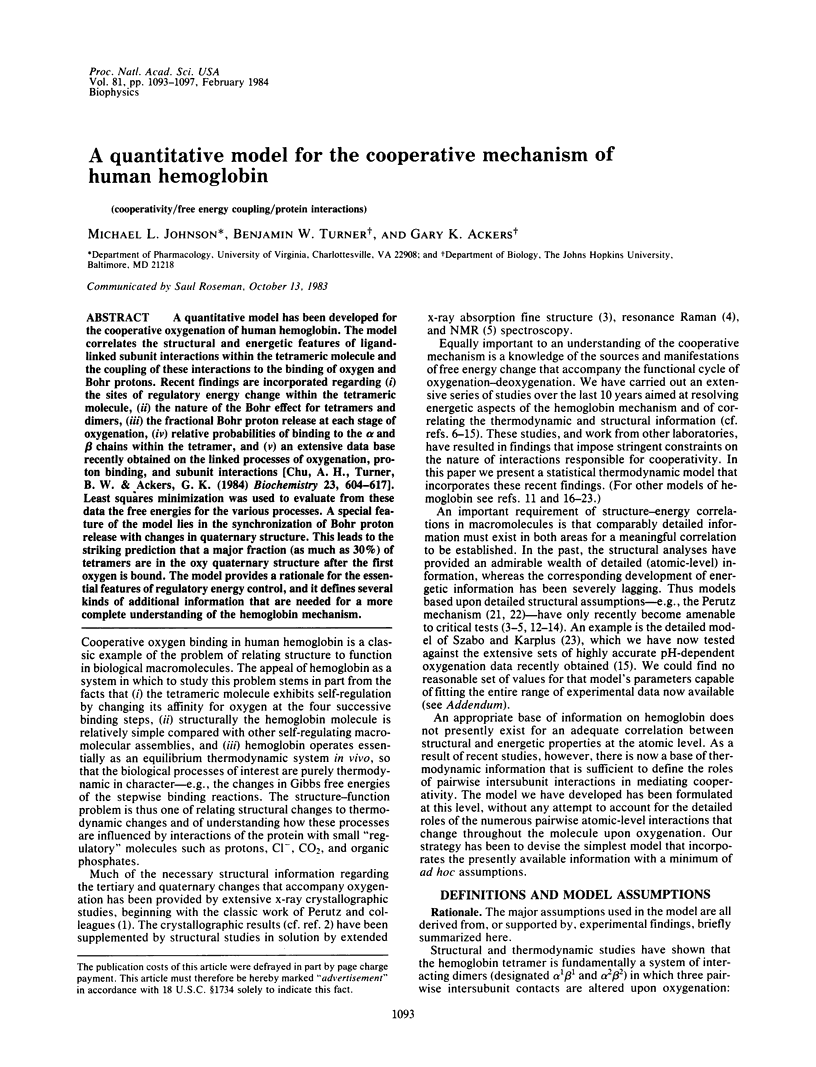
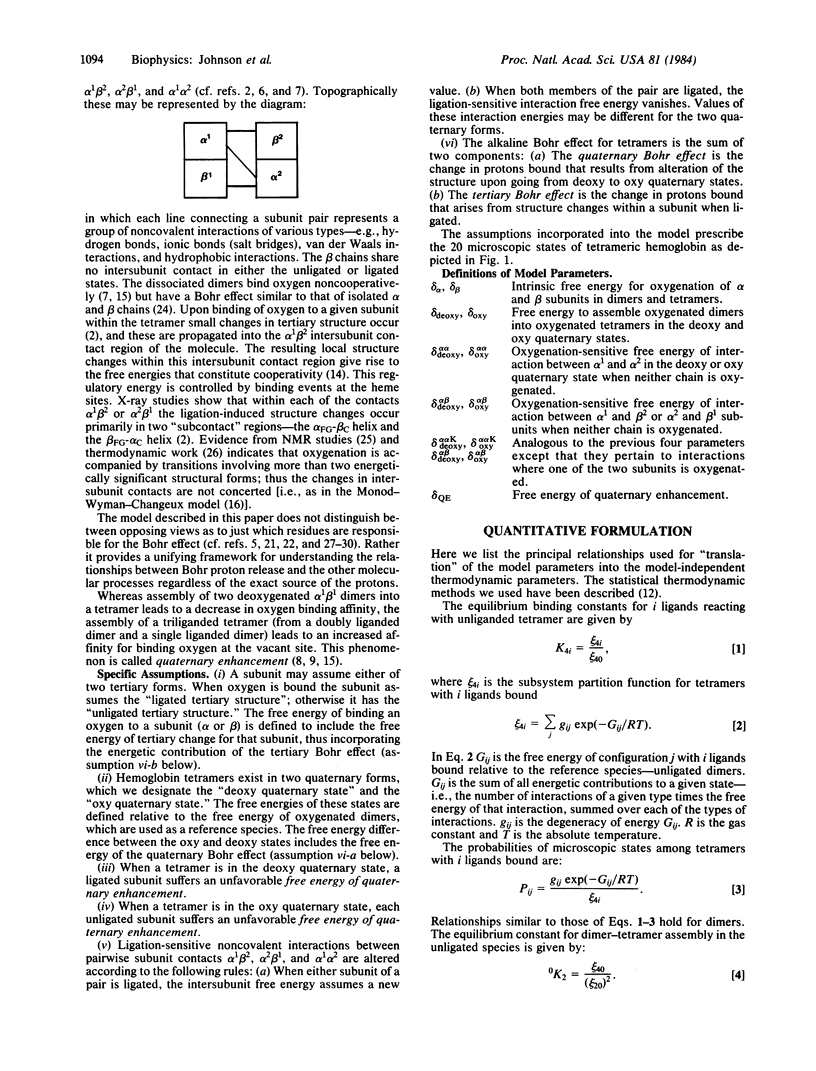
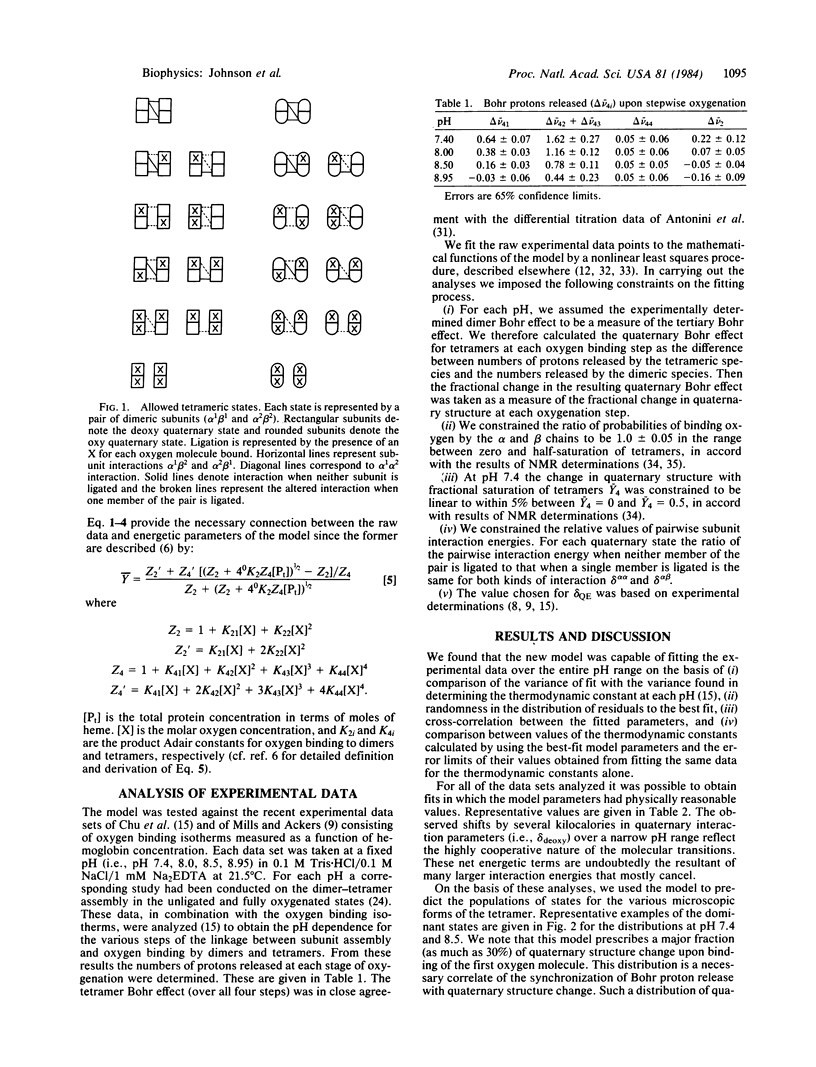
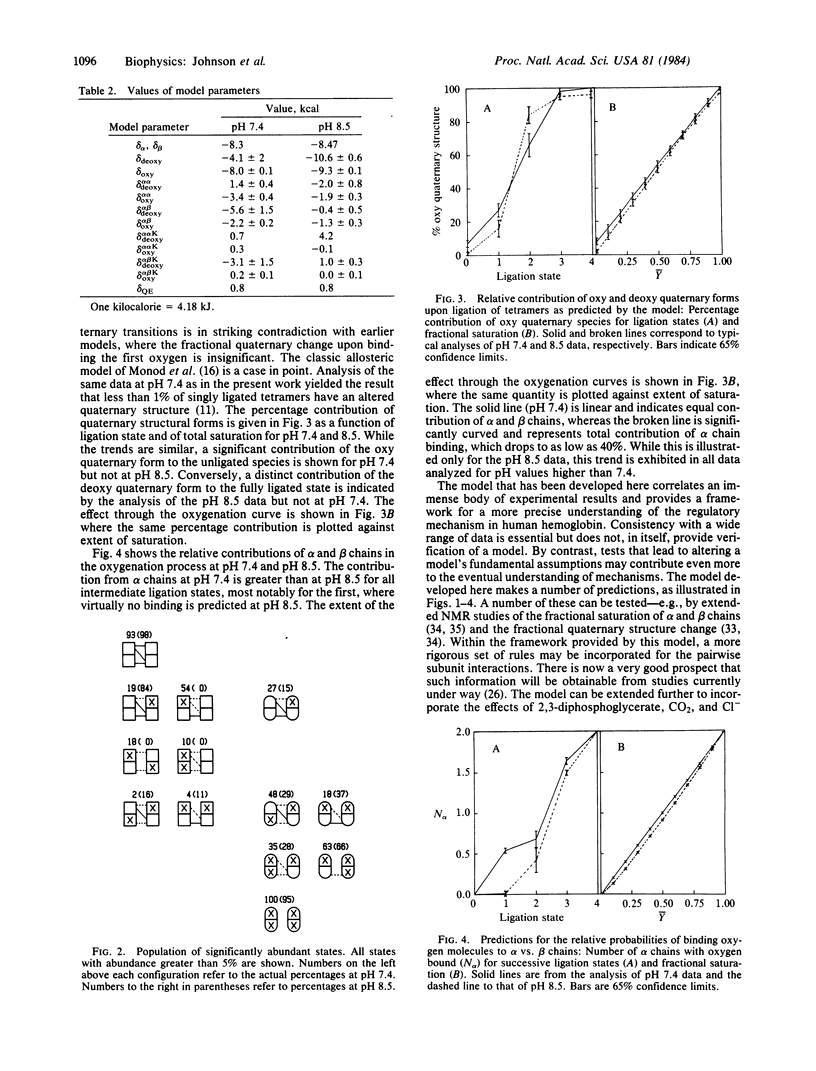
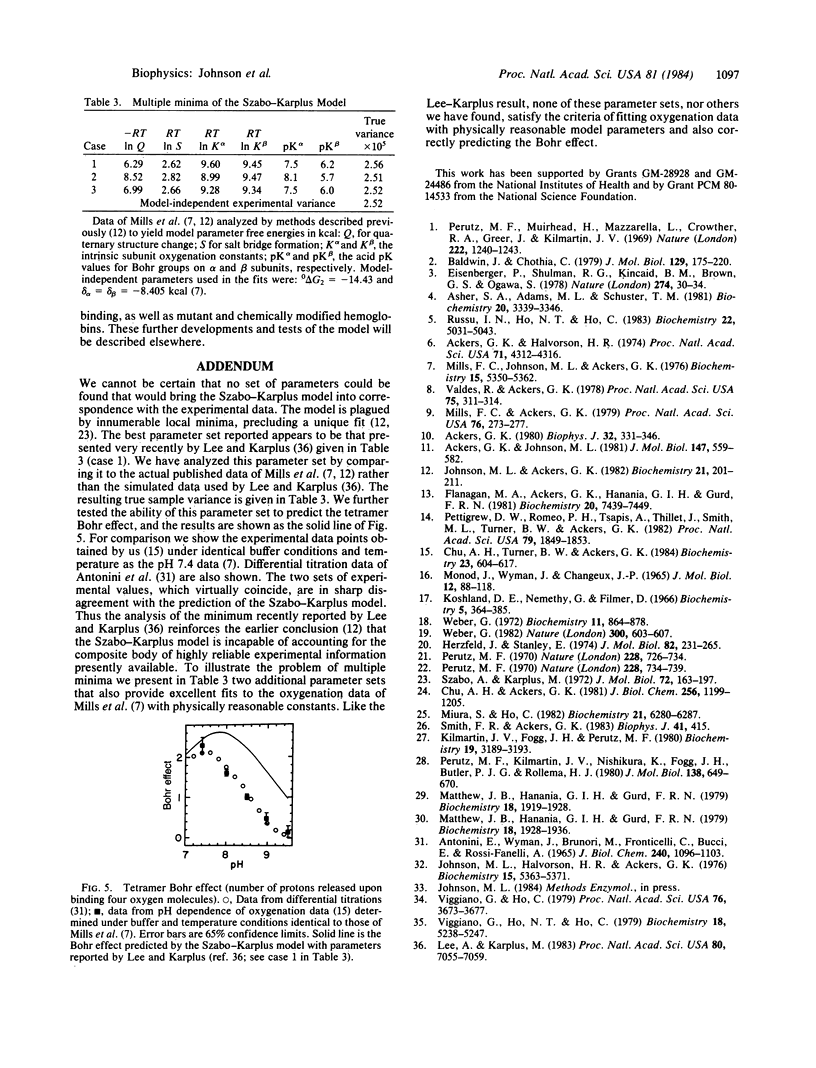
Selected References
These references are in PubMed. This may not be the complete list of references from this article.
- ANTONINI E., WYMAN J., BRUNORI M., FRONTICELLI C., BUCCI E., ROSSI-FANELLI A. STUDIES ON THE RELATIONS BETWEEN MOLECULAR AND FUNCTIONAL PROPERTIES OF HEMOGLOBIN. V. THE INFLUENCE OF TEMPERATURE ON THE BOHR EFFECT IN HUMAN AND IN HORSE HEMOGLOBIN. J Biol Chem. 1965 Mar;240:1096–1103. [PubMed] [Google Scholar]
- Ackers G. K. Energetics of subunit assembly and ligand binding in human hemoglobin. Biophys J. 1980 Oct;32(1):331–346. doi: 10.1016/S0006-3495(80)84960-5. [DOI] [PMC free article] [PubMed] [Google Scholar]
- Ackers G. K., Halvorson H. R. The linkage between oxygenation and subunit dissociation in human hemoglobin. Proc Natl Acad Sci U S A. 1974 Nov;71(11):4312–4316. doi: 10.1073/pnas.71.11.4312. [DOI] [PMC free article] [PubMed] [Google Scholar]
- Ackers G. K., Johnson M. L. Linked functions in allosteric proteins. Extension of the concerted (MWC) model for ligand-linked subunit assembly and its application to human hemoglobins. J Mol Biol. 1981 Apr 25;147(4):559–582. doi: 10.1016/0022-2836(81)90400-9. [DOI] [PubMed] [Google Scholar]
- Asher S. A., Adams M. L., Schuster T. M. Resonance Raman and absorption spectroscopic detection of distal histidine--fluoride interactions in human methemoglobin fluoride and sperm whale metmyoglobin fluoride: measurements of distal histidine ionization constants. Biochemistry. 1981 Jun 9;20(12):3339–3346. doi: 10.1021/bi00515a004. [DOI] [PubMed] [Google Scholar]
- Baldwin J., Chothia C. Haemoglobin: the structural changes related to ligand binding and its allosteric mechanism. J Mol Biol. 1979 Apr 5;129(2):175–220. doi: 10.1016/0022-2836(79)90277-8. [DOI] [PubMed] [Google Scholar]
- Chu A. H., Ackers G. K. Mutual effects of protons, NaCl, and oxygen on the dimer-tetramer assembly of human hemoglobin. The dimer Bohr effect. J Biol Chem. 1981 Feb 10;256(3):1199–1205. [PubMed] [Google Scholar]
- Eisenberger P., Shulman R. G., Kincaid B. M., Brown G. S., Ogawa S. Extended X-ray absorption fine structure determination of iron nitrogen distances in haemoglobin. Nature. 1978 Jul 6;274(5666):30–34. doi: 10.1038/274030a0. [DOI] [PubMed] [Google Scholar]
- Flanagan M. A., Ackers G. K., Matthew J. B., Hanania G. I., Gurd F. R. Electrostatic contributions to the energetics of dimer-tetramer assembly in human hemoglobin: pH dependence and effect of specifically bound chloride ions. Biochemistry. 1981 Dec 22;20(26):7439–7449. doi: 10.1021/bi00529a018. [DOI] [PubMed] [Google Scholar]
- Herzfeld J., Stanley H. E. A general approach to co-operativity and its application to the oxygen equilibrium of hemoglobin and its effectors. J Mol Biol. 1974 Jan 15;82(2):231–265. doi: 10.1016/0022-2836(74)90343-x. [DOI] [PubMed] [Google Scholar]
- Johnson M. L., Ackers G. K. Thermodynamic analysis of human hemoglobins in terms of the Perutz mechanism: extensions of the Szabo--Karplus model to include subunit assembly. Biochemistry. 1982 Jan 19;21(2):201–211. doi: 10.1021/bi00531a001. [DOI] [PubMed] [Google Scholar]
- Johnson M. L., Halvorson H. R., Ackers G. K. Oxygenation-linked subunit interactions in human hemoglobin: analysis of linkage functions for constituent energy terms. Biochemistry. 1976 Nov 30;15(24):5363–5371. doi: 10.1021/bi00669a024. [DOI] [PubMed] [Google Scholar]
- Kilmartin J. V., Fogg J. H., Perutz M. F. Role of C-terminal histidine in the alkaline Bohr effect of human hemoglobin. Biochemistry. 1980 Jul 8;19(14):3189–3183. doi: 10.1021/bi00555a013. [DOI] [PubMed] [Google Scholar]
- Koshland D. E., Jr, Némethy G., Filmer D. Comparison of experimental binding data and theoretical models in proteins containing subunits. Biochemistry. 1966 Jan;5(1):365–385. doi: 10.1021/bi00865a047. [DOI] [PubMed] [Google Scholar]
- Lee A. W., Karplus M. Structure-specific model of hemoglobin cooperativity. Proc Natl Acad Sci U S A. 1983 Dec;80(23):7055–7059. doi: 10.1073/pnas.80.23.7055. [DOI] [PMC free article] [PubMed] [Google Scholar]
- MONOD J., WYMAN J., CHANGEUX J. P. ON THE NATURE OF ALLOSTERIC TRANSITIONS: A PLAUSIBLE MODEL. J Mol Biol. 1965 May;12:88–118. doi: 10.1016/s0022-2836(65)80285-6. [DOI] [PubMed] [Google Scholar]
- Matthew J. B., Hanania G. I., Gurd F. R. Electrostatic effects in hemoglobin: Bohr effect and ionic strength dependence of individual groups. Biochemistry. 1979 May 15;18(10):1928–1936. doi: 10.1021/bi00577a012. [DOI] [PubMed] [Google Scholar]
- Matthew J. B., Hanania G. I., Gurd F. R. Electrostatic effects in hemoglobin: hydrogen ion equilibria in human deoxy- and oxyhemoglobin A. Biochemistry. 1979 May 15;18(10):1919–1928. doi: 10.1021/bi00577a011. [DOI] [PubMed] [Google Scholar]
- Mills F. C., Ackers G. K. Quaternary enhancement in binding of oxygen by human hemoglobin. Proc Natl Acad Sci U S A. 1979 Jan;76(1):273–277. doi: 10.1073/pnas.76.1.273. [DOI] [PMC free article] [PubMed] [Google Scholar]
- Mills F. C., Johnson M. L., Ackers G. K. Oxygenation-linked subunit interactions in human hemoglobin: experimental studies on the concentration dependence of oxygenation curves. Biochemistry. 1976 Nov 30;15(24):5350–5362. doi: 10.1021/bi00669a023. [DOI] [PubMed] [Google Scholar]
- Miura S., Ho C. Preparation and proton nuclear magnetic resonance investigation of cross-linked mixed valency hybrid hemoglobins: models for partially oxygenated species. Biochemistry. 1982 Nov 23;21(24):6280–6287. doi: 10.1021/bi00267a037. [DOI] [PubMed] [Google Scholar]
- Perutz M. F., Kilmartin J. V., Nishikura K., Fogg J. H., Butler P. J., Rollema H. S. Identification of residues contributing to the Bohr effect of human haemoglobin. J Mol Biol. 1980 Apr 15;138(3):649–668. doi: 10.1016/s0022-2836(80)80022-2. [DOI] [PubMed] [Google Scholar]
- Perutz M. F., Muirhead H., Mazzarella L., Crowther R. A., Greer J., Kilmartin J. V. Identification of residues responsible for the alkaline Bohr effect in haemoglobin. Nature. 1969 Jun 28;222(5200):1240–1243. doi: 10.1038/2221240a0. [DOI] [PubMed] [Google Scholar]
- Perutz M. F. Stereochemistry of cooperative effects in haemoglobin. Nature. 1970 Nov 21;228(5273):726–739. doi: 10.1038/228726a0. [DOI] [PubMed] [Google Scholar]
- Pettigrew D. W., Romeo P. H., Tsapis A., Thillet J., Smith M. L., Turner B. W., Ackers G. K. Probing the energetics of proteins through structural perturbation: sites of regulatory energy in human hemoglobin. Proc Natl Acad Sci U S A. 1982 Mar;79(6):1849–1853. doi: 10.1073/pnas.79.6.1849. [DOI] [PMC free article] [PubMed] [Google Scholar]
- Szabo A., Karplus M. A mathematical model for structure-function relations in hemoglobin. J Mol Biol. 1972 Dec 14;72(1):163–197. doi: 10.1016/0022-2836(72)90077-0. [DOI] [PubMed] [Google Scholar]
- Valdes R., Jr, Ackers G. K. Self-association of hemoglobin betaSH chains is linked to oxygenation. Proc Natl Acad Sci U S A. 1978 Jan;75(1):311–314. doi: 10.1073/pnas.75.1.311. [DOI] [PMC free article] [PubMed] [Google Scholar]
- Viggiano G., Ho C. Proton nuclear magnetic resonance investigation of structural changes associated with cooperative oxygenation of human adult hemoglobin. Proc Natl Acad Sci U S A. 1979 Aug;76(8):3673–3677. doi: 10.1073/pnas.76.8.3673. [DOI] [PMC free article] [PubMed] [Google Scholar]
- Viggiano G., Ho N. T., Ho C. Proton nuclear magnetic resonance and biochemical studies of oxygenation of human adult hemoglobin in deuterium oxide. Biochemistry. 1979 Nov 13;18(23):5238–5247. doi: 10.1021/bi00590a031. [DOI] [PubMed] [Google Scholar]
- Weber G. Asymmetric ligand binding by haemoglobin. Nature. 1982 Dec 16;300(5893):603–607. doi: 10.1038/300603a0. [DOI] [PubMed] [Google Scholar]
- Weber G. Ligand binding and internal equilibria in proteins. Biochemistry. 1972 Feb 29;11(5):864–878. doi: 10.1021/bi00755a028. [DOI] [PubMed] [Google Scholar]


